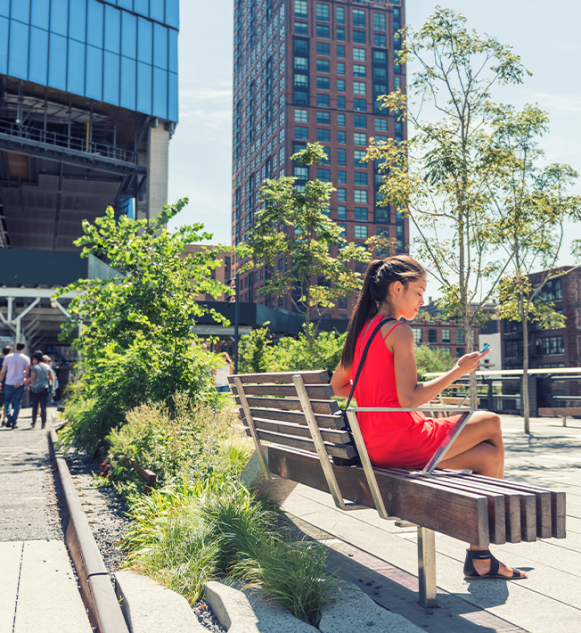Transform the way you design client spaces with placemaking principles that keep community in mind. Creating a stunning space is about more than designing a look that is pleasing - it’s about building a functional place that benefits a community's ever-changing needs. That’s where placemaking - a multi-faceted approach to the planning, design and management of public spaces - comes into play. Placemaking looks at the experience of the community and builds from the bottom up with influence from local collaborators.
While placemaking is commonly thought of in public spaces and urban design, utilizing some of the same tactics can revolutionize your commercial projects for the better. By keeping these 5 elements for successful placemaking in mind, you’ll build more than just physical spaces, but places people want to be.

Image Source: Custom EchoFold Mini installation at Ferebee Hope High School. Designed by Studio Twentyseven Architecture. Photo by Anice Hoachlander.
1. Encourage and empower organic use of the space
In placemaking, how spaces are used organically drives your vision. Observation is key to learning about the space, the natural use of it, and finding out what is missing to make it more functional. Take time to gather information about how the space is working well and build your vision around how you can enhance the existing good. By adding to natural use instead of working against it, you’ll create a space that people won’t want to leave.
“A good (space) is like a good party – people stay longer than really necessary because they are enjoying themselves.”
- Jan Gehl, Danish Architect & global leader in people centered urban design

2. Strengthen existing connections between people and places
Create the right vision for a space by collaborating with stakeholders. Placemaking turns to the community members to strengthen the connection between the place and the people utilizing it. In urban design, this may mean looking to community leaders, local businesses, government and nonprofit partners to work together on the vision. Within commercial design, try collaborating with HR departments, leaders at the facility, or staff that knows the space well and how it’s actually used. This insight can lead to more thoughtful designs that exceed the client’s needs.

"Triangulation is the process by which some external stimulus provides a linkage between people and prompts strangers to talk to other strangers as if they knew each other."
- Holly Whyte, American urbanist, sociologist, organizational analyst, journalist
You can also strengthen connections between people within the space by adding design features that encourage interaction. Creating a common, flexible workspace that is out of the way may mean it’s underutilized. But if you put this space near a coffee station and waste bin, a natural use will occur. This method is known as triangulation. Thoughtful triangulation of office amenities can lead to better communication between departments and stronger team relationships.

3. Embrace local identity to craft a theme
Placemaking requires community participation. That’s why observation and involving stakeholders is crucial to delivering a successful vision. Those steps allow you to get to know the personality and culture of the client so you can better express that identity through your designs. When you embrace, enhance, and express a community’s sense of self, it creates an enjoyable experience for all those who inhabit the space. You can create spaces as unique as your clients with bold statement walls and custom designed acoustic walls that create healthy spaces for occupants while conveying a strong theme around logos, mantras, aesthetics and more.

Image Source: Geometry Tiles installation at Two Rivers Middle School. Designed by Studio Twentyseven Architecture. Photo by Anice Hoachlander.
4. Inclusivity means making a space for all
Frame your vision around inclusivity. Good design is accessible to all. In urban spaces, accessibility could mean adding multi-use paths for bikes, walking, etc., being near public transit lines, or possibly adding wayfinding messages to help direct visitors. You can accomplish wayfinding in your designs with custom printed wallcovering or color blocking to demarcate spaces. You can also try creating calming spaces for special sensory needs. With tactile wallcoverings that tackle rogue soundwaves, you can build spaces that are healthy and soothing instead of a sensory overload.

5. Always remain adaptable
Placemaking is an on-going process that responds to ever-evolving needs of the community. You can incorporate this into your designs by creating spaces that can adapt with client needs as they change. It’s important for spaces to remain flexible and respond to the way people use it organically. This is especially true as hybrid work schedules seem to dominate the corporate scene. Make work settings functional for different uses with moveable acoustic partitions or adding in overhead acoustic baffles in high traffic areas with a lot of noise.
Placemaking tactics need not be limited to public spaces. Observing organic use of a space, enhancing the natural function, and strengthening the connection between the space and the people within can reimagine the way you think about design. Up your design game by reflecting the needs of folks utilizing your work the most - the client and its community.
Make places people won’t want to leave.
Explore adaptable acoustic products that change with your clients ever-evolving needs. Talk to a rep today and start collaborating.
